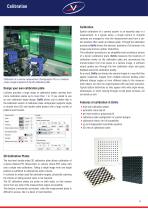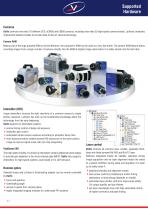
Catalog excerpts

Software for Intelligent Imaging
Open the catalog to page 1
All LaVision's intelligent imaging systems are driven by DaVis, our powerful and comprehensive software for data acquisition, visualization and processing. Why DaVis? ► comprehensive software solution for multi-dimensional, multi-parameter (laser) imaging ► ultimate system integration built on fully software embedded device control ► leading edge image processing algorithms ► DaVis is extensively field proven and continuously enhanced by our experienced team of engineers and scientists ► based on more than 25 years of leadership in multi-parameter imaging Features and Benefits 4 leading...
Open the catalog to page 2
Modularity Modularity in DaVis is achieved by the combination of the DaVis platform with application specific modules. This means that you only invest in functionality that you need, and upgrade paths are open to future extensions. From an operator point of view this concept provides a common software experience for all packages. Basic activities like recording, processing and exporting data are similar in almost all application specific packages. Integration DaVis as the foundation integrates all software and hardware components in a single platform. All hardware is fully integrated to...
Open the catalog to page 3
DaVis Project Integrating all tasks in a DaVis project DaVis Dialog Concept You can do many tasks with DaVis: record images with up to 8 fully synchronized cameras simultaneously. Process image data to obtain a flow field, temperature map, or particle statistics. Export results for further evaluation or presentation. Make use of built-in wizards to accomplish optimum results. This all runs from the same DaVis software. There is no need to switch between different programs for different tasks. Each specific application is associated with a unique DaVis project type and this makes you focus...
Open the catalog to page 4
User Interface Data viewer – presenting multiple dimensions The project data viewer is a central part in DaVis for browsing, viewing and managing your data. With the multi-parameter imaging systems from LaVision you will easily create multidimensional data. Starting with the 2 dimensions each camera has, DaVis adds the 3rd dimension by tomographic reconstruction or physical scanning. Time as the 4th dimension will be added by investigation of transient phenomena with time-resolved or phase-locked recordings. 4Level 3: task specific dialogs For each task, DaVis presents a full screen...
Open the catalog to page 5
Processing with DaVis Processing is the core functionality of DaVis: doing the computational work on recorded images. Data from LaVision‘s imaging systems are normally arranged in sets with tens or hundreds of camera image files. Image data from a camera are unprocessed and contain grey-scale (or color coded) 2-dimensional light intensity information. The “processing” removes image artefacts (like background and laser intensity gradients), applies filters (like smoothing, noise reduction, thresholding) and converts them to the desired physical property, or into a 3-dimensional...
Open the catalog to page 6
GPU Acceleration Speed! Computing thousands of raw images with sophisticated algorithms like PIV takes your valuable time. Therefore, it is our goal to reduce the computing time without making any compromise in result quality and precision. DaVis combines several techniques to accelerate the built-in processing functions, like using GPU cards and parallel processing. The best performance is achieved in combination with a fast storage system, like a RAID disk array. GPU – processing acceleration with latest technology GPUs (Graphics Processing Units) are originally designed to accelerate...
Open the catalog to page 7
Distance plane to plane: | * ,* | 5,00 ! Mark properties [mm] Mark form: | ^ Dot w | Mark size i | # J | 5,00 5 Distance mark to mark: • ~%\ 20,00 Z Frontside First plane Number of marks in grid; XI 13 @ X: II | Totati 130 171 Second plane Number of marks in grid: X: is 5 9ffi:Totalt 162 Design your own calibration plate LaVision provides a large range of calibration plates, starting from micro calibration plates up to more than 1 m. If you intend to use an own calibration target design, DaVis allows you to define that in the calibration wizard. A...
Open the catalog to page 8
Self-Calibration LaVision has developed algorithms for an easy and quick calibration. The ‘Self-Calibration’ method is a unique tool to correct even large misalignments between calibration plate and laser light sheet with the recorded particle images themselves used to calculate this misalignment. The mapping function is corrected accordingly and the recorded images are evaluated. LaVision’s Self-Calibration method is a standard feature of LaVision’s Stereo-PIV software DaVis. Benefits of Self-Calibration 4higher accuracy: elimination of calibration errors 4user-friendly: free positioning...
Open the catalog to page 9
Features 4fully synchronized recording of mixed camera and laser types with other devices 4phase locking and phase scanning for periodic events, including rotary encoders for engine test beds 4continuous rate mode and frame straddling mode for timeresolved PIV measurements 4independent timing groups (reference times) and user defined trigger solve even complex trigger designs 4trigger prediction for periodic triggers allows “negative” delays 4multi exposure for improved S/N ratio with intensifiers 4Graphical Connector Interface (GCI) 4in-system firmware updates keep the PTU up to date with...
Open the catalog to page 10
Cameras DaVis controls more than 70 different CCD, sCMOS and CMOS cameras, including more than 25 high-speed camera models. LaVision constantly implements selected models to provide state-of-the-art camera technology. Making use of the huge possible RAM on 64 bit Windows, the computer’s RAM can be used as a very fast buffer. The camera RAM feature allows recording images from a larger number of cameras directly into the RAM at highest image rates before it is safely stored onto the hard disk. Intensifier (IRO) Image intensifies increase the light sensitivity of a common camera to...
Open the catalog to page 11All LaVision GmbH catalogs and technical brochures
-
Focus on Fluid Dynamics
12 Pages
-
Focus on Combustion
16 Pages
-
StrainMaster
20 Pages
-
FlowMaster
16 Pages
-
PIV poster
1 Pages
-
Particle Image Velocimetry
1 Pages
-
LIF poster
1 Pages
-
Tomographic PIV
20 Pages
-
StrainMaster Portable
8 Pages
-
StrainMaster Micro-DIC
8 Pages
-
SprayMaster
16 Pages
-
ParticleMaster
4 Pages
-
Optical Crack Tracer
4 Pages
-
MTZ 06/2013, Berg et al.
6 Pages
-
ICOS
12 Pages
-
Laser Imaging in Fluid Dynamics
12 Pages
-
Quantitative Flow Field Analysis
12 Pages
-
Fluid-Structure Interaction
2 Pages
-
Imager sCMOS
2 Pages
-
Imager M-lite 2M
2 Pages

























